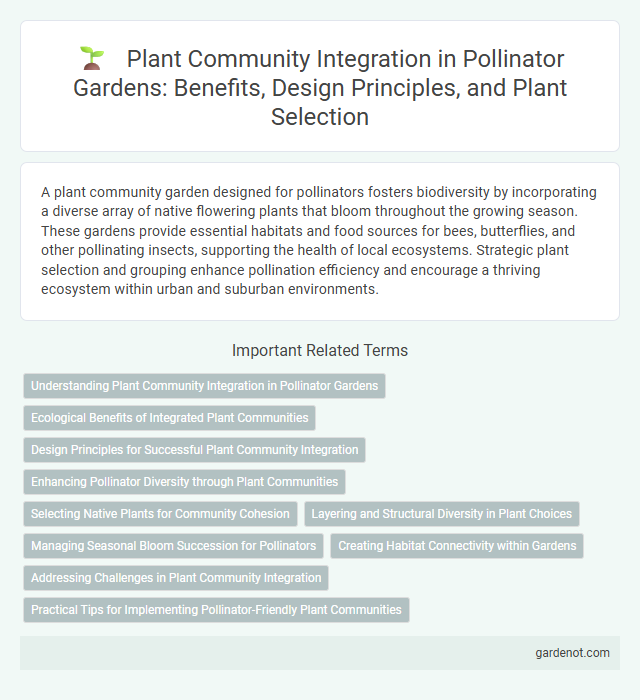A plant community garden designed for pollinators fosters biodiversity by incorporating a diverse array of native flowering plants that bloom throughout the growing season. These gardens provide essential habitats and food sources for bees, butterflies, and other pollinating insects, supporting the health of local ecosystems. Strategic plant selection and grouping enhance pollination efficiency and encourage a thriving ecosystem within urban and suburban environments.
Understanding Plant Community Integration in Pollinator Gardens
Plant community integration in pollinator gardens enhances biodiversity and supports ecosystem resilience by combining native flowering plants, shrubs, and groundcovers that attract diverse pollinator species such as bees, butterflies, and hummingbirds. This strategic assembly of plant species promotes natural pest control, soil health, and continuous bloom cycles, ensuring a sustainable habitat for pollinators throughout the growing season. Understanding the ecological relationships and spatial arrangement within these plant communities is crucial for maximizing pollination efficiency and garden productivity.
Ecological Benefits of Integrated Plant Communities
Integrated plant communities in pollinator gardens enhance biodiversity by creating diverse habitats that support various pollinator species, including bees, butterflies, and hummingbirds. These plant groupings improve soil health through natural nutrient cycling and promote resilience against pests and diseases, reducing the need for chemical interventions. The ecological benefits of such gardens extend to increased pollination efficiency, which supports local agriculture and contributes to overall ecosystem stability.
Design Principles for Successful Plant Community Integration
Effective design principles for a pollinator plant community garden include selecting native, nectar-rich plants that bloom sequentially to provide continuous forage. Incorporating diverse plant heights and structures creates microhabitats, supporting varied pollinator species such as bees, butterflies, and hummingbirds. Emphasizing soil health with organic amendments and minimizing chemical use enhances plant vitality and ecosystem resilience.
Enhancing Pollinator Diversity through Plant Communities
Plant community gardens enhance pollinator diversity by supporting a wide range of native flowering plants that provide continuous bloom throughout the growing season. Diverse plant species create varied habitats and foraging opportunities for bees, butterflies, and other pollinators, promoting ecosystem resilience. Incorporating native perennials, shrubs, and groundcovers increases nectar and pollen availability, essential for sustaining healthy pollinator populations.
Selecting Native Plants for Community Cohesion
Selecting native plants for a pollinator garden enhances community cohesion by supporting local biodiversity and attracting native pollinators such as bees, butterflies, and hummingbirds. Native plants like milkweed, coneflower, and goldenrod provide essential nectar and pollen sources that sustain pollinator populations and improve ecosystem health. Integrating these species into a community garden fosters environmental stewardship and strengthens social bonds through shared conservation efforts.
Layering and Structural Diversity in Plant Choices
Creating a pollinator garden with a diverse plant community emphasizes layering and structural diversity to maximize habitat variety and food sources. Incorporating ground covers, herbaceous plants, shrubs, and flowering trees ensures continuous bloom periods and supports a wide array of pollinators such as bees, butterflies, and hummingbirds. This vertical and horizontal stratification improves microclimates, enhances nutrient cycling, and fosters resilient, self-sustaining ecosystems.
Managing Seasonal Bloom Succession for Pollinators
Managing seasonal bloom succession in a pollinator garden ensures continuous nectar and pollen sources for bees, butterflies, and other beneficial insects throughout the growing season. Planting a diverse community of native flowering species with staggered bloom times supports pollinator health and biodiversity by providing habitat and food from early spring to late fall. Regular monitoring and adaptive maintenance promote optimal flowering patterns, enhancing ecosystem resilience and pollination efficiency.
Creating Habitat Connectivity within Gardens
Establishing a plant community garden enhances habitat connectivity by linking diverse native flowering species that offer continuous nectar and pollen resources for pollinators. Structured layers of plants, including ground covers, wildflowers, shrubs, and small trees, create ecological corridors encouraging pollinator movement and genetic exchange. Integrating these interconnected habitats supports robust pollinator populations and biodiversity within urban and suburban landscapes.
Addressing Challenges in Plant Community Integration
Designing a pollinator garden with diverse plant community integration requires selecting native species that thrive together while supporting pollinator biodiversity. Overcoming challenges such as competition for resources and varying bloom times involves strategic spatial arrangement and succession planting to ensure continuous floral availability. Incorporating plants with complementary root structures and growth habits enhances soil health and reduces invasive species risk, promoting a resilient and sustainable pollinator habitat.
Practical Tips for Implementing Pollinator-Friendly Plant Communities
Select a diverse range of native flowering plants that bloom sequentially from early spring to late fall to ensure continuous nectar and pollen sources for pollinators. Incorporate plants of varying heights and structures to accommodate different pollinator species, promoting habitat complexity and shelter. Regularly monitor the garden for invasive species and avoid pesticide use to maintain a healthy, thriving pollinator community.
Plant community garden Infographic

 gardenot.com
gardenot.com